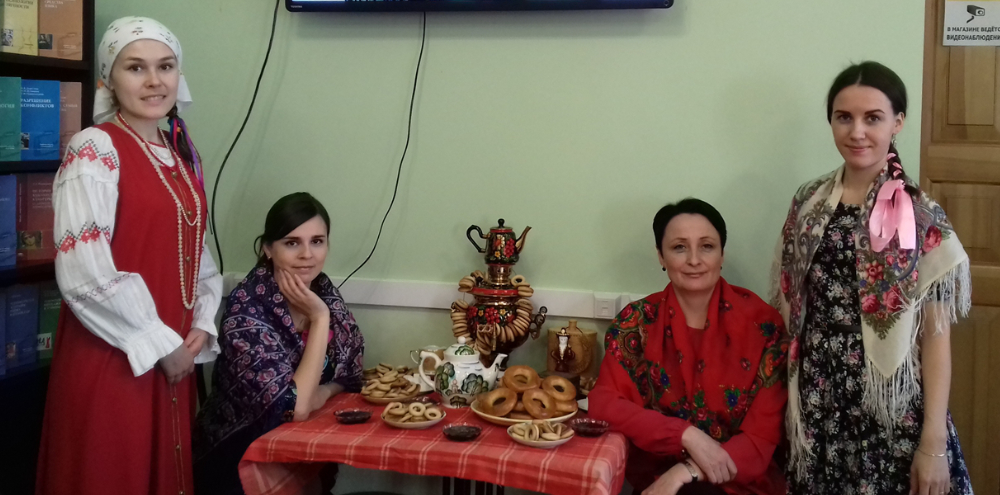
ULAANBAATAR, Mongolia
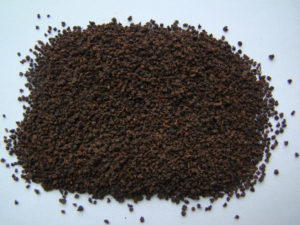
In the time of the great Khans a caravan laden with four “poods” of tea found favor with Tsar Mikhail Fyodorovich but the “outlandish dried leaf” baffled his court.
A pood is a Russian unit of mass equal to 40 funt, loosely translated it means “a very large amount” of tea (in this instance 64 kilograms).
Vasily Starkov, Moscow’s ambassador to the Mongolian empire, the ranking diplomat who accompanied the caravan in 1638, responded with a generous pile of mink-skin fur as tribute in hopes of retaining peaceful coexistence with the Mongolian Altan Khan, a leader among Genghis Khan’s golden tribe. Starkov was mindful of the fact that in 1156 the Golden Horde had invaded what was then Rus, burning Moscow to the ground and killing all who lived there.
Initially, Russian rulers could not find the meaning of this gift. Tea was not completely unknown, in 1567 two Cossack atamans, Petrov and Yalyshev, had visited China where they encountered tea, likely consumed with butter and salt, but carried none back. The wise men of the tsar’s court began researching and experimenting and soon observed that the brewed leaf was delicious and had medical properties. Tea quickly gained popularity in Russia where it is loved not only for its warmth and taste but also for remedial benefits.
Tea drinking was likely more common and a much older tradition in far off East Siberia which lies north of China.
Today Russia is the world’s largest importer of tea and one of the top five tea drinking nations, consuming 9% of global exports. Consumer research indicates 98% of Russians drink tea regularly, averaging about three pounds per person annually.
The cold northern climate led Russians to view tea as the national beverage and, while coffee consumption is growing, tea’s low price and ready availability make it the first choice among beverages.
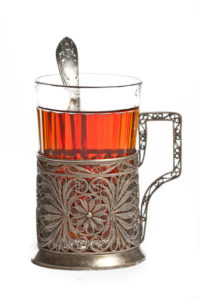
Baikhovy tea
The origins of Sino-Russian tea trade date to 1679. The Russian word for tea is chay (чай in Cyrillic). The finest of these imports were known as “baikhovy” tea (байховый) a fabulous white tea that traveled to Russia from southern China, along the “Great Tea Horse Road.”
When Russian traders began to conduct business with Chinese tea merchants, without knowing their language or their customs, they encountered the Chinese word “bai hao” which describes the presence of tips — very young leaf buds that lend flavor and aroma.
“Slightly changing this word, making it familiar to the Russian rumor, they ended up calling all Chinese tea baikhovy. For Russian tea traders at that time the term was synonymous with high quality. Translated from the native tongue “bai hao” it describes the “white cilium” or tiny white hairs that surround the bud. Bai Hao Yin Zhen, known as silver needle, is a white tea still produced in China’s Fujian province. Zhenghe and Fuding, spanning the north to north-eastern parts of Fujian, are the major and original producers of this tea.
Among white teas, silver needle is the most expensive, as uniformly sized newly sprouted buds (leaf shoots) are used to produce the tea. Genuine silver needle is made from cultivars of the Da Bai (large white) tea trees. Similar downy leaf shoots can be found in many green teas, but taste and a distinct biochemical potency set the genuine white tea silver needle apart. It is revered among China’s famous teas and sells online for $64 for 8 oz (227 grams) in the U.S. or $285 per kilo. In China, the price is much higher.
Russians favor black tea and dark tea and oolongs. One of the country’s favorite is Russian Caravan tea, a blend of oolong, keemum, and lapsang souchong. This aromatic tea is sweet, malty and slightly smoky depending on the percentage of lapsang in the blend.
In time baikhovy came to describe all finer quality loose leaf teas (green, oolong and black) and was used to distinguish it from the so-called brick or tile tea, which at that time was lower quality.
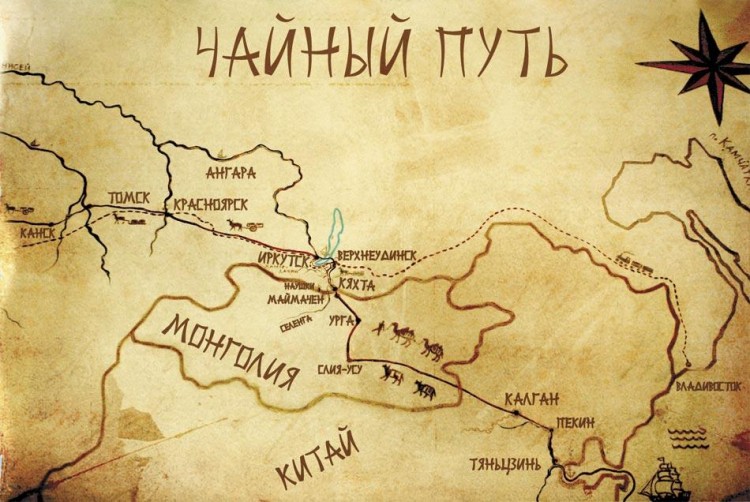
Russian tea culture
Russian tea culture is extraordinary. Tea-drinking is viewed as a way of relaxing, a conversation starter and is important in resolving work matters and reconciliation. Polite and well-mannered behavior is expected in the presence of a samovar at Russian family gatherings. Remaining calm, no matter what the situation, is a sign of respect for the head of the family.
The ever-present “samovar” (самoвар) has become a symbol of hospitality and inseparable from Russian tea culture. These large spherical or conical metal containers traditionally used to boil water and brew tea in Russia. It is the center of the Russian tea universe.
The first samovar factory was in Tula, in western Russia, about 100 years after the arrival of the first caravan. The inventor’s name remains unknown. The Lisitsyn family of metalworkers and weapon makers are the first documented samovar-makers. Living in the city of Tula in the 18th and 19th centuries their first version dates to 1778 and their various designs were very influential. Production peaked at 625 handmade samovars a year, many elaborately decorated.
The samovar is very beautiful, a decoration on the table and the subject around which people gather and communicate. A teapot sits atop the device which is fueled with wood or coal. Farm families use the samovar widely, especially in Siberia. The harsher the climate, the more honored the samovar. The number of samovars in the household could serve as an indicator of the prosperity of the family. The samovar keeps the heat so that water for tea does not cool down for a long time. Tea consumption is highest in the Siberian cities of Irkutsk, Novosibirsk, and Krasnoyarsk. Cold winters led to greater demand for hot drinks.
Tea and sugar are inseparable to tea drinkers. Surprisingly, the first domestic sugar factory was located in Tula which is about 193 kilometers from Moscow. From the earliest times, it became common to drink tea through pieces of sugar (vprikusku). The vprikusku ritual involved chipping small pieces of sugar from a bigger lump. Tea drinkers then put a bite-sized piece of sugar between their front teeth and sip hot tea through it, lending a sweet taste. In contemporary Siberia, this custom remains common among the elderly.
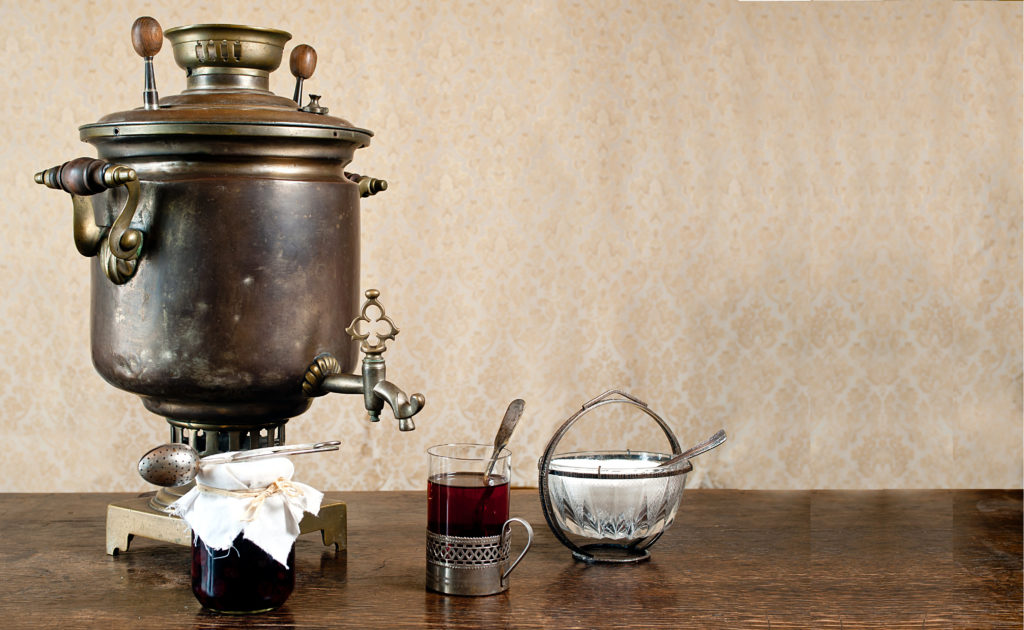
Brewing Russian style tea
The initial step is to boil fresh, cold water. In earlier times, Russians brought water in the samovar to a boil by stuffing the chimney with dried wood and setting fire to it outdoors. Red hot embers and coals accumulated in the Samovar’s vertical tube which is surrounded by a water chamber. Today most families use an electric water boiler.
A prominent feature in Russian tea preparation is the two-step brewing process. First, a tea concentrate called zavarka (заварка) is prepared. A quantity of dry tea sufficient for several servings is placed in a small teapot. Hot water is then added from the samovar’s reservoir, dispensed by spigot. Infusion time is approximately 3-10 minutes. Each person then pours some quantity of the concentrate into their glass or cup and mixes it with hot water from the samovar. Once poured, the small metal teapot is returned to the top of the chimney to stay hot.
The technique allows everyone in the family to make their tea as strong they prefer. Thereafter, sugar, jam, honey or lemon is added to the brew.
It is compulsory that various pastries accompany tea, an indication of the big soul of Russians. Serving pastries is still a vital element of the tea drinking ritual. The doughnut-shaped bread-roll, kalatch, is often strung from the samovar and served with butter, home-baked cakes, and factory produced biscuits.
A traditional break continues for at least a half hour.